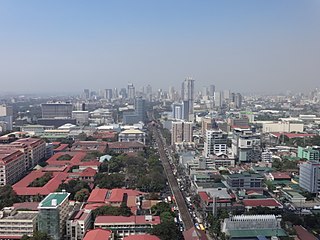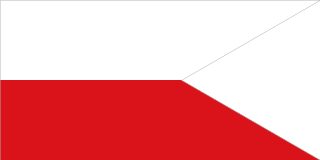
Metropolitan Manila, commonly shortened to Metro Manila and formally the National Capital Region, is the capital region and largest metropolitan area of the Philippines. Located on the eastern shore of Manila Bay, the region lies between the Central Luzon and Calabarzon regions. Encompassing an area of 619.57 km2 (239.22 sq mi) and with a population of 13,484,462 as of 2020, it is composed of sixteen highly urbanized cities: the capital city, Manila, Caloocan, Las Piñas, Makati, Malabon, Mandaluyong, Marikina, Muntinlupa, Navotas, Parañaque, Pasay, Pasig, Quezon City, San Juan, Taguig, and Valenzuela, along with one independent municipality, Pateros. As the second most populous and the most densely populated region in the Philippines, it ranks as the 9th most populous metropolitan area in Asia and the 6th most populous urban area in the world.

Rizal, officially the Province of Rizal, is a province in the Philippines located in the Calabarzon region in Luzon. Its capital is the city of Antipolo. It is about 16 kilometers (9.9 mi) east of Manila. The province is named after José Rizal, one of the main national heroes of the Philippines. It is bordered by Metro Manila to the west, Bulacan to the north, Quezon to the east and Laguna to the southeast. The province also lies on the northern shores of Laguna de Bay, the largest lake in the country. Rizal is a mountainous province perched on the western slopes of the southern portion of the Sierra Madre mountain range.

Malabon, officially the City of Malabon, is a 1st class highly urbanized city in the National Capital Region of the Philippines. According to the 2020 census, it has a population of 380,522 people.

Manila Water Company, Inc. has the exclusive right to provide water and used water (wastewater) services to over six million people in the East Zone of Metro Manila. It is a subsidiary of the country's oldest conglomerate, Ayala Corporation.

Mega Manila is a megalopolis on the island of Luzon in the Philippines. There are varying definitions of the megalopolis, but it is generally seen as encompassing the administrative regions of Central Luzon, Calabarzon, and Metro Manila. On some occasions, the administrative region of Mimaropa is also included.

The legislative districts of Rizal are the representations of the province of Rizal in the various national and local legislatures of the Philippines. At present, the province is represented in the House of Representatives of the Philippines by its four congressional districts, with the districts' representatives being elected every three years. Additionally, each district is allotted a certain number of seats in the Rizal Provincial Board, with board members also being elected every three years.

The La Mesa Dam and Reservoir is an earth dam in Quezon City, Philippines. Its reservoir can hold up to 50.5 million cubic meters, occupying an area of 27 square kilometers (10 sq mi). It is part of the Angat-Ipo-La Mesa water system, which supplies most of the water supply of Metro Manila.
The Philippines' water supply system dates back to 1946, after the country declared independence. Government agencies, local institutions, non-government organizations, and other corporations are primarily in charge of the operation and administration of water supply and sanitation in the country.
Water privatization in Metro Manila began when the then President of the Philippines, Fidel Ramos, instructed the government in 1994 to solve what he called the water crisis in Manila by engaging with the private sector. In 1997, two concession contracts for the Eastern and Western halves of Metro Manila were awarded after an open competition. The concessions represent the largest population served by private operators in the developing world. Both winning companies, Maynilad Water Services in West Manila and especially Manila Water in East Manila, submitted bids with extremely low water tariffs. The tariffs proved to be too low to finance the investments needed to improve performance, especially after the East Asian financial crisis and the devaluation of the Philippine Peso.

Metro Pacific Investments Corporation (MPIC) is a Philippine-based unit investment holding company of First Pacific Company Limited through Metro Pacific Holdings, Inc. MPIC through its subsidiaries, provides water, sanitation, and sewerage services and also operates in real estate, and infrastructure projects. It also invests in some hospitals in the Philippines.

Manila, also known as Tondo until 1859, was a province of the Philippines that encompassed the former pre-Hispanic polities of Tondo, Maynila, and Namayan. In 1898, it comprised the city of Manila and 23 other municipalities. In 1901, the province was dissolved, with the city of Manila absorbing six of its smaller neighboring municipalities. The remaining part was merged with the adjacent district of Morong to form the province of Rizal.

Circumferential Road 4 (C-4), informally known as the C-4 Road, is a network of roads and bridges that all together form the fourth beltway of Metro Manila in the Philippines. Spanning some 27.35 kilometers (16.99 mi), it connects the cities of Caloocan, Makati, Malabon, Mandaluyong, Navotas, Pasay, Quezon City, and San Juan.

The Metropolitan Waterworks and Sewerage System, formerly known as the National Waterworks and Sewerage System Authority (NAWASA), is the government agency that is in charge of water privatization in Metro Manila and nearby provinces of Cavite and Rizal in the Philippines. It split the water concession into an east and a west concession with Manila Water being awarded one contract and Maynilad Water Services being awarded the other.
DMCI Homes, Inc. is the real estate arm of DMCI Holdings through its wholly owned subsidiary DMCI Project Developers, Inc. (PDI). It was incorporated and registered with the Securities and Exchange Commission (SEC) on April 27, 1995. It ranked #146 in the Business World Top 1000 Corporations for 2014.

The following outline is provided as an overview of and topical guide to Metro Manila:

The following is an alphabetical list of articles related to the Philippine capital region of Metro Manila.
The Caloocan–Malabon–Navotas (CAMANA) Water Reclamation Facility is a sewage treatment plant under-construction in Caloocan, Metro Manila, Philippines. If completed, it will become the largest sewage treatment plant in the Philippines with a capacity to process 205 million liters (54,000,000 U.S. gal) of used water daily.
The Sumag River Diversion Project (SRDP) is an expansion project of the Umiray-Angat Transbasin Project (UATP) Metropolitan Waterworks and Sewerage System (MWSS) for the supply of the Angat Dam reservoir. The 600 meter long and 2.50 meter diameter tunnel-aqueduct system diverts waters from the Sumag River, a tributary of the Umiray River, east of the Angat Basin. The SRDP is forecasted to add 188 mld to the existing 777.6 mld capacity of the UATP.
Navotas Island is an island in the city of Navotas, Philippines. Situated in the Tullahan River delta, it is surrounded on the west by Manila Bay, on the north by the Tangos River, on the east by the Navotas River, and on the south by the Tullahan River. The city center or poblacion of Navotas is located on the island. With an estimated land area of 1.95 km2, Navotas Island is one of the most densely populated islands in the world.















